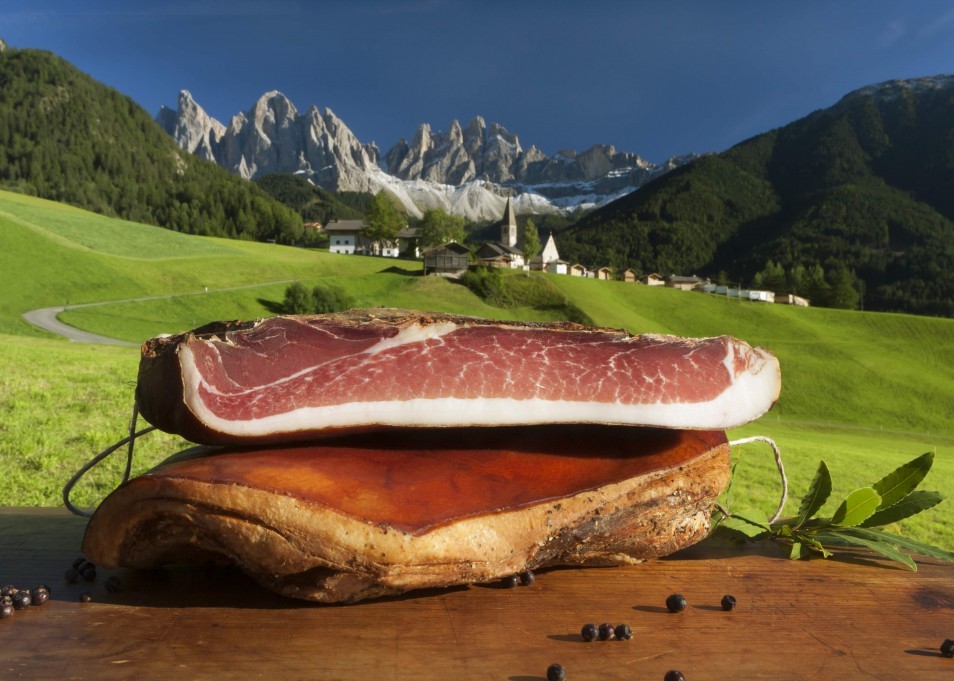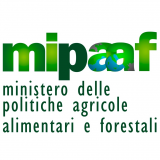
Speck was created hundreds of years ago through the symbiosis of two methods for preserving meat: curing, which was widespread in the Mediterranean area, and smoking, typical of northern Europe. As such, Alto Adige, a land that merges the two cultures, gave rise to a speciality with an unmistakable production process and taste, made according to the traditional rule of “a little salt, a little smoke and a lot of air”.
Its tradition is very old indeed: as early as 1200, several documents testify to the existence of speck as a product derived from the necessity of preserving pork slaughtered during the Christmas period for the rest of the year.
In local Alto Adige tradition, speck was a food eaten by peasants and provided a good source of energy when working in the fields. Over time, this product became one of the main dishes served at feasts and banquets, and even today it remains a mainstay of typical South Tyrolean snacks, along with bread and wine.
The product
Speck Alto Adige IGP (Protected Geographical Indication) a raw ham that is lightly smoked and cured in pure air, with an inimitable look and taste. Its excellent nutritional values, moderate amount of calories and high percentage of valuable proteins make Speck Alto Adige an ideal foodstuff at mealtimes and a good alternative to fresh meat, eggs and cheese.
As can be deduced from the name, the term Speck Alto Adige IGP can only be applied to Speck made in Alto Adige by working the pork thighs following the historical methods. The ingredients have remained the same over the centuries: salt, smoke, lots of fresh mountain air and a lengthy curing period. Only once all these criteria have been met and the checks have been carried out can speck receive its designation of origin.
Production
Speck Alto Adige IGP is only made from lean, hard pork thighs originating from herds of pigs that are properly treated, recognised and monitored. The thighs are cut according to traditional methods.
The baffe (shoulders of speck) are sprinkled with salt and a special blend of spices then undergo dry salmistratura (aromatic curing) for three weeks in a fresh environment. Each producer has their own personal recipe for the exact mixture of salt, pepper, bay leaves, juniper and rosemary, which is kept secret. It is important to make sure that the final amount of salt does not exceed 5%, however.
After the salmistratura, the baffe are exposed in turns to five days of light smoking using wood with a small amount of resin, then the fresh air of the South Tyrolean mountain valleys. The temperature of the smoke must not exceed 20°C. Only then does the Speck take on its unmistakable finely spiced aroma.
The baffe take around 22 weeks to cure and become a delicacy. They are hung in places with plenty of the pure, fresh mountain air of the South Tyrolean valleys. During this phase, the Speck loses around a third of its initial weight and thereby acquires its typical consistency. During the curing, a natural layer of aromatic mould forms, rounding off the characteristic flavour.
To ensure the quality and authenticity of Speck Alto Adige IGP, the Consortium for the Protection of Speck Alto Adige, in conjunction with the independent monitoring body INEQ (Istituto Nord Est Qualità – North East Quality Institute), has developed a system to verify compliance with the criteria throughout all the phases of processing and producing speck. The inspectors can freely access the production sites at any time to carry out the required checks: verification of curing time, checks on the consistency and probing for olfactory tests, as well as sample testing of the salt content.
The local area
Situated in the extreme north of Italy, on the border with Austria and Switzerland, Alto Adige is one of Italy’s most renowned provinces because of its beauty and its mountains. The area in which speck is produced is particularly well suited for creating this product: the South Tyrolean microclimate, with its dry and fresh mountain air, allows curing to occur gradually and slowly.
The meat is smoked with beech wood and juniper berries, which grow on the local slopes and are ideal for flavouring the speck. Added to this are the technical skills of the qualified workers of Alto Adige, which has allowed them to continue production processes that remain completely true to the established tradition of these places.
By Consorzio Tutela Speck Alto Adige with MiPAAF



